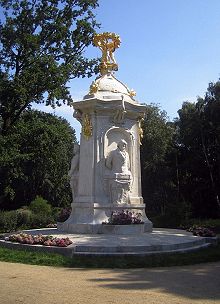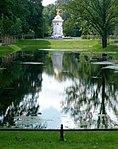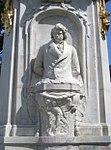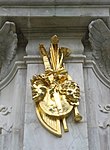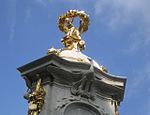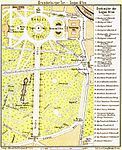Beethoven-Haydn-Mozart monument
The Beethoven-Haydn-Mozart monument (also known as the composer 's monument ) was erected in 1904 by Rudolf and Wolfgang Siemering in the Großer Tiergarten , a central park in Berlin, in honor of the composers Ludwig van Beethoven , Joseph Haydn and Wolfgang Amadeus Mozart .
Description of the monument
The 10 m high monument stands near the Flora Square , at the southern end of the goldfish pond. There is a half-length figure of the composer on each of its three sides. The monument is made of Greek and Tyrolean marble and has a domed roof with three putti holding a laurel wreath on the gilded tip . On the roof and on the narrow strips between the three fronts there are more gold-plated bronze and copper electroplating. The marble reliefs , which symbolically illustrate the work of the musicians below the statues , were once partially gilded.
The outer shape of the monument is reminiscent of the appearance of the room-high, richly decorated tiled stoves with which middle-class Berlin apartments were often equipped around 1900. Against this background, so-called popular names such as “musicians oven” or “three men oven” are to be understood, which are occasionally reproduced in texts about the monument. The extent to which such names are authentic cannot be clearly clarified.
history
According to the existing monuments to the poets Johann Wolfgang von Goethe , Friedrich Schiller and Gotthold Ephraim Lessing , the three composers Beethoven, Haydn and Mozart should also be honored in the Tiergarten. The sculptor Rudolf Siemering won the competition for a suitable monument, but had to revise and simplify his original design several times. As an architect, his son Wolfgang supervised the work, which was completed in 1904.
During fighting towards the end of the Second World War , the monument suffered significant damage and several parts disappeared. Some inadequate repairs were made after the war ended. In 1996 the construction of the Tiergarten tunnel was imminent; it could have endangered the facility, which was already in great need of restoration. As a precaution, all essential parts except for the brick core were removed and stored.
In 2001 a comprehensive restoration began under the supervision of the State Monuments Office. The management of all work was the "restoration of the Oberbaum", the total cost of 960,000 euros was taken over by the Senate Department for Urban Development . The administration saw a particular reason for the elaborate work in the fact that “ the Beethoven-Haydn-Mozart monument is one of the few examples of symbolist art in public space ”.
Many of the approximately 145 individual parts of the dismantled monument were damaged by bullets at the end of the war and later willful destruction, marble elements were riddled with cracks and colored green by copper salts. The marble could be stabilized by special processes and finally received an anti- graffiti layer. Some missing parts - for example Mozart's nose tip - were added, but traces of the war and post-war should also remain recognizable. Various lost metal parts - masks, musical instruments, flower hangings - had to be reconstructed from historical photos and postcards. After the Tiergarten tunnel had been completed and the decades-long temporary structure of the relief road had been removed and planted, the reconstruction of the monument could begin. The last work on the base was completed in summer 2007.
gallery
Web links
- Golden putti for the Tiergarten - Berliner Morgenpost ( Memento from July 3, 2007 in the Internet Archive )
- Senate Department for Urban Development
- Pictures from the monument
- Tagesspiegel: “A new tip of the nose for Mozart” , from February 8, 2006
Individual evidence
- ↑ http://www.stadtentwicklung.berlin.de/aktuell/pressebox/includes/archiv/arch_0612/nachricht2532.html
Coordinates: 52 ° 30 ′ 49.5 ″ N , 13 ° 22 ′ 13.2 ″ E
